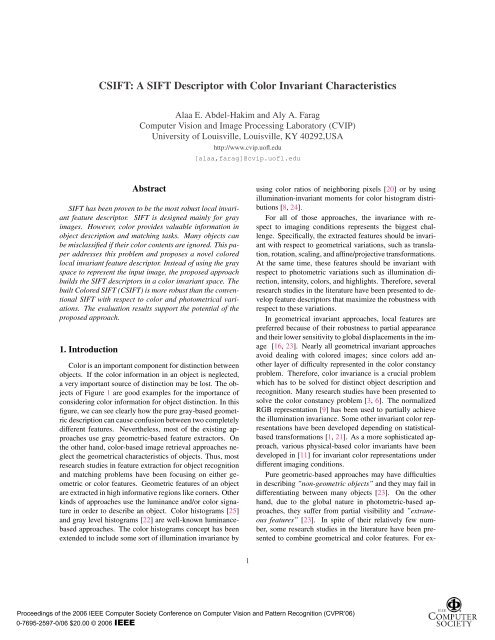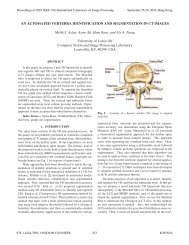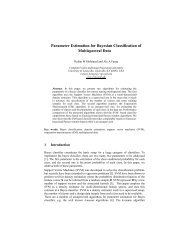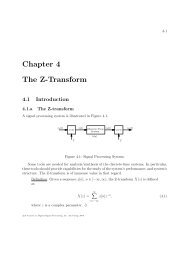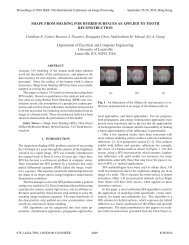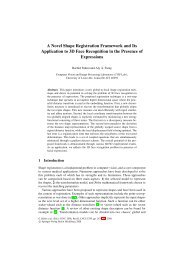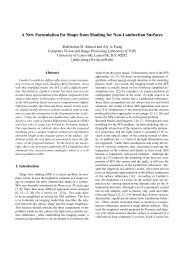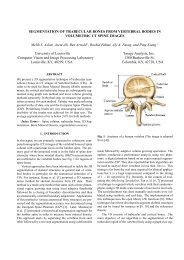CSIFT: A SIFT Descriptor with Color Invariant Characteristics
CSIFT: A SIFT Descriptor with Color Invariant Characteristics
CSIFT: A SIFT Descriptor with Color Invariant Characteristics
Create successful ePaper yourself
Turn your PDF publications into a flip-book with our unique Google optimized e-Paper software.
<strong>C<strong>SIFT</strong></strong>: A <strong>SIFT</strong> <strong>Descriptor</strong> <strong>with</strong> <strong>Color</strong> <strong>Invariant</strong> <strong>Characteristics</strong><br />
Alaa E. Abdel-Hakim and Aly A. Farag<br />
Computer Vision and Image Processing Laboratory (CVIP)<br />
University of Louisville, Louisville, KY 40292,USA<br />
Abstract<br />
<strong>SIFT</strong> has been proven to be the most robust local invariant<br />
feature descriptor. <strong>SIFT</strong> is designed mainly for gray<br />
images. However, color provides valuable information in<br />
object description and matching tasks. Many objects can<br />
be misclassified if their color contents are ignored. This paper<br />
addresses this problem and proposes a novel colored<br />
local invariant feature descriptor. Instead of using the gray<br />
space to represent the input image, the proposed approach<br />
builds the <strong>SIFT</strong> descriptors in a color invariant space. The<br />
built <strong>Color</strong>ed <strong>SIFT</strong> (<strong>C<strong>SIFT</strong></strong>) is more robust than the conventional<br />
<strong>SIFT</strong> <strong>with</strong> respect to color and photometrical variations.<br />
The evaluation results support the potential of the<br />
proposed approach.<br />
1. Introduction<br />
<strong>Color</strong> is an important component for distinction between<br />
objects. If the color information in an object is neglected,<br />
a very important source of distinction may be lost. The objects<br />
of Figure 1 are good examples for the importance of<br />
considering color information for object distinction. In this<br />
figure, we can see clearly how the pure gray-based geometric<br />
description can cause confusion between two completely<br />
different features. Nevertheless, most of the existing approaches<br />
use gray geometric-based feature extractors. On<br />
the other hand, color-based image retrieval approaches neglect<br />
the geometrical characteristics of objects. Thus, most<br />
research studies in feature extraction for object recognition<br />
and matching problems have been focusing on either geometric<br />
or color features. Geometric features of an object<br />
are extracted in high informative regions like corners. Other<br />
kinds of approaches use the luminance and/or color signature<br />
in order to describe an object. <strong>Color</strong> histograms [25]<br />
and gray level histograms [22] are well-known luminancebased<br />
approaches. The color histograms concept has been<br />
extended to include some sort of illumination invariance by<br />
http://www.cvip.uofl.edu<br />
[alaa,farag]@cvip.uofl.edu<br />
1<br />
using color ratios of neighboring pixels [20] or by using<br />
illumination-invariant moments for color histogram distributions<br />
[8, 24].<br />
For all of those approaches, the invariance <strong>with</strong> respect<br />
to imaging conditions represents the biggest challenge.<br />
Specifically, the extracted features should be invariant<br />
<strong>with</strong> respect to geometrical variations, such as translation,<br />
rotation, scaling, and affine/projective transformations.<br />
At the same time, these features should be invariant <strong>with</strong><br />
respect to photometric variations such as illumination direction,<br />
intensity, colors, and highlights. Therefore, several<br />
research studies in the literature have been presented to develop<br />
feature descriptors that maximize the robustness <strong>with</strong><br />
respect to these variations.<br />
In geometrical invariant approaches, local features are<br />
preferred because of their robustness to partial appearance<br />
and their lower sensitivity to global displacements in the image<br />
[16, 23]. Nearly all geometrical invariant approaches<br />
avoid dealing <strong>with</strong> colored images; since colors add another<br />
layer of difficulty represented in the color constancy<br />
problem. Therefore, color invariance is a crucial problem<br />
which has to be solved for distinct object description and<br />
recognition. Many research studies have been presented to<br />
solve the color constancy problem [3, 6]. The normalized<br />
RGB representation [9] has been used to partially achieve<br />
the illumination invariance. Some other invariant color representations<br />
have been developed depending on statisticalbased<br />
transformations [1, 21]. As a more sophisticated approach,<br />
various physical-based color invariants have been<br />
developed in [11] for invariant color representations under<br />
different imaging conditions.<br />
Pure geometric-based approaches may have difficulties<br />
in describing ”non-geometric objects” and they may fail in<br />
differentiating between many objects [23]. On the other<br />
hand, due to the global nature in photometric-based approaches,<br />
they suffer from partial visibility and ”extraneous<br />
features” [23]. In spite of their relatively few number,<br />
some research studies in the literature have been presented<br />
to combine geometrical and color features. For ex-<br />
Proceedings of the 2006 IEEE Computer Society Conference on Computer Vision and Pattern Recognition (CVPR’06)<br />
0-7695-2597-0/06 $20.00 © 2006 IEEE
Figure 1. Neglecting the color content may affect the object distinction.<br />
Note the big similarity between the two magnified corners<br />
which occurs when discarding the color information.<br />
ample, in [12], color and shape invariants are combined for<br />
image retrieval. However, the color invariants in that approach<br />
are very sensitive to the noise around their singularities.<br />
Also, the geometrical invariants are primitive when<br />
compared <strong>with</strong> the pure gray-based approaches.<br />
Scale <strong>Invariant</strong> Feature Transform (<strong>SIFT</strong>) [16, 17] has<br />
been proven to be the most robust among the other local<br />
invariant feature descriptors <strong>with</strong> respect to different geometrical<br />
changes [19]. <strong>SIFT</strong> was mainly developed for gray<br />
images which limits its performance <strong>with</strong> some colored objects.<br />
However, there are some attempts in the literature<br />
which have been introduced to make use of the color information<br />
inside the <strong>SIFT</strong> descriptors. For example, in [4],<br />
the normalized RGB model has been used in combination<br />
<strong>with</strong> <strong>SIFT</strong> to achieve partial illumination invariance besides<br />
its geometrical invariance. The color invariance of this approach<br />
is still limited because of the primitive color model<br />
used. In [7], a multi-stages recognition approach has been<br />
developed in order to achieve both color and geometrical<br />
invariance. In the first stage, a color classifier is used label<br />
the different image regions. Then, the <strong>SIFT</strong> descriptors are<br />
augmented by adding the color labels. In spite of the good<br />
performance of this approach, its need for colored learning<br />
instances limits its performance in several applications.<br />
In this paper, we present a novel <strong>Color</strong>ed <strong>SIFT</strong> (<strong>C<strong>SIFT</strong></strong>),<br />
not to just embed the color information in the descriptors,<br />
but to give the built descriptor the robustness <strong>with</strong> respect<br />
to color variations as well as the robustness of the conventional<br />
<strong>SIFT</strong> against geometrical changes. The proposed<br />
<strong>C<strong>SIFT</strong></strong> approach is compared to the conventional <strong>SIFT</strong> approach<br />
[16, 17]. The evaluation results show that <strong>C<strong>SIFT</strong></strong> is<br />
more stable and distinctive <strong>with</strong> respect to variations in the<br />
photometrical imaging conditions.<br />
2. Problem Statement<br />
The problem of object description using local invariant<br />
approaches can be looked at as the problem of transforming<br />
the object image into a set of feature vectors or descriptors.<br />
For good object description, two criteria should<br />
be satisfied in the extracted features. The first one is the<br />
stability, i.e. the extracted features should be invariant to<br />
different photometric and geometric changes. The second<br />
one is the distinctiveness, which means that the extracted<br />
features should have the minimum information to distinguish<br />
between the object which they describe and other objects.<br />
In section (3), we discuss the geometrical invariance,<br />
whereas in section (4) we focus on the color invariance. In<br />
section (5), we explain our proposed <strong>C<strong>SIFT</strong></strong> approach for<br />
combining both geometrical and color invariants in a single<br />
descriptor. Finally, we show some evaluation results that<br />
support the potential of <strong>C<strong>SIFT</strong></strong>.<br />
3. Geometrical Invariance<br />
Geometrical invariance means the invariance of the extracted<br />
features to translation, rotation, scaling, or affine<br />
transformations as well as occlusion and partial appearance.<br />
In other words, for a specific object, a feature F (x) at a location<br />
x =(x, y) should satisfy the following condition:<br />
F (x) =F (Tx) (1)<br />
where T is a transformation which includes translation, rotation,<br />
scaling or affine transformation.<br />
The locality of the extracted features and the way in<br />
which the descriptors are built provides the invariance <strong>with</strong><br />
respect to these geometrical variations, as shown in section<br />
(5). The more challenging point is the invariance to<br />
scale changes.<br />
Scale-space theory offers the main tools for selecting the<br />
most robust feature locations, or the interest points, against<br />
scale variations. Given a signal f : R N → R, the scalespace<br />
representation L : R N × R+ → R is defined as:<br />
L(x, t) =g(x, t) ∗ f(x) (2)<br />
where L(x, 0) = f(x)∀x ∈ R N and g(x, t) is the scalespace<br />
kernel. As t increases, the scale-space representation<br />
L(x, t) of the signal tends to coarser scales.<br />
It has been proven that the Gaussian kernel is the unique<br />
kernel for generating the scale-space representation [15].<br />
Moreover, Lindeberg [14] has shown that the normalization<br />
of the Laplacian of Gaussian, ∇ 2 g, <strong>with</strong> a factor σ 2 = t<br />
is necessary to give a signal the scale-invariance property.<br />
Empirically, it has been proven that the maxima and minima<br />
of σ 2 ∇ 2 g produces the most stable image features [18]. The<br />
normalized Laplacian of Gaussian pyramid can be approximated<br />
by a difference-of-Gaussian pyramid [17]. Hence,<br />
Proceedings of the 2006 IEEE Computer Society Conference on Computer Vision and Pattern Recognition (CVPR’06)<br />
0-7695-2597-0/06 $20.00 © 2006 IEEE
the locations of the maxima and minima in the differenceof-Gaussian<br />
pyramid correspond to the most stable features<br />
<strong>with</strong> respect to scale changes.<br />
4. <strong>Color</strong> Invariance<br />
In this paper, we use the color invariance model, which<br />
was developed by Geusebroek et.al [11] to build our <strong>C<strong>SIFT</strong></strong><br />
descriptors. So, in this section, we give a brief description<br />
of the invariants in this model.<br />
In this model, the color invariants depend on the old<br />
Kubelka-Munk theory which models the reflected spectrum<br />
of colored bodies [13, 26]. The Kubelka-Munk theory<br />
models the photometric reflectance by:<br />
E(λ, x) =e(λ, x)(1 − ρf (x)) 2 R∞(λ, x)+e(λ, x)ρf (x)<br />
(3)<br />
where λ is the wavelength and x is a 2D vector which<br />
denotes the image position. e(λ, x) denotes the illumination<br />
spectrum and ρf (x) is the Fresnel reflectance at<br />
x. R∞(λ, x) denotes the material reflectivity. E(λ, x)<br />
represents the reflected spectrum in the viewing direction.<br />
This model is suitable for modelling non-transparent/nontranslucent<br />
materials. Some special cases can be derived<br />
from Eq. (3). For example, the Fresnel coefficient can be<br />
neglected for matte and dull surfaces. By assuming equal<br />
energy illumination, the spectral components of the source<br />
are constant over the wavelengthes and variable over the<br />
position, which is applicable for most of the practical cases.<br />
So, they can be denoted as i(x). Then, Eq. (3) will be:<br />
E(λ, x) =i(x)[ρf (x)+(1− ρf (x)) 2 R∞(λ, x)] (4)<br />
By differentiating Eq. (4) <strong>with</strong> respect to λ, we get:<br />
Eλ = i(x)(1 − ρf (x)) 2 ∂R∞(λ, x)<br />
∂λ<br />
and<br />
Eλλ = i(x)(1 − ρf (x)) 2 ∂2R∞(λ, x)<br />
∂λ2 (6)<br />
By dividing Eq. (5) by Eq. (6), we get:<br />
<br />
Eλ<br />
H = =<br />
Eλλ<br />
∂R∞(λ, x)<br />
/<br />
∂λ<br />
∂2R∞(λ, x)<br />
∂λ2 = f(R∞(λ, x)) (7)<br />
<br />
Eλ<br />
Thus, H = is the reflectance property which is inde-<br />
Eλλ<br />
pendent of viewpoint, surface orientation, illumination direction,<br />
intensity, and Fresnel reflectance coefficient.<br />
By considering only matte and dull surfaces for the<br />
model of Eq. (3), i.e. ρf ≈ 0 and E = i(x)R∞(λ, x)<br />
(which is the Lambertian model under the constraint of<br />
equal energy illumination), another object reflectance property<br />
Cλ = Eλ<br />
E is provided as an invariant to the viewpoint,<br />
surface orientation, illumination direction and illumination<br />
intensity. By adding an assumption of planar objects<br />
(5)<br />
to the previous assumptions, Wx = <br />
Ex<br />
E is given as an<br />
invariant to the changes in the illumination intensity. For<br />
matte and dull surfaces <strong>with</strong> single illumination spectrum<br />
Nλx = ExE−EλEx<br />
E2 <br />
is given as an object reflectance property<br />
that is independent of the viewpoint, surface orientation,<br />
illumination direction, illumination intensity, and illumination<br />
color. Hence, Nλx determines material transitions<br />
independent of illumination color and intensity distribution.<br />
Higher order derivatives for these invariants are used for<br />
more robust representations. For the detailed derivation of<br />
these invariants, the reader is referred to [11].<br />
To calculate these invariants from the known RGB color<br />
space, the Gaussian color model is used as a general model<br />
for representation of spectral information and local image<br />
structure [11]. In this model, a linear transformation<br />
from the RGB space is used to obtain spectral differential<br />
quotients( Ê,Êλ, Êλλ). Then, spatial differential quotients<br />
( Êx, Êλx, Êλλx) are obtained by convolution <strong>with</strong> Gaussian<br />
derivative filters. A good approximation for the human<br />
vision system and for the CIE 1964 XYZ basis can be<br />
obtained by taking λo = 520nm and σλ =55nm when<br />
calculating the first three components ( Ê,Êλ, Êλλ) ofthe<br />
Gaussian color model [11]. Using the product of two linear<br />
transformations, one from RGB to XYZ and the other from<br />
XYZ to the Gaussian color model [11], the desired implementation<br />
of the Gaussian color model in terms of RGB can<br />
be obtained, as shown in Eq. (8). Measurement of the color<br />
invariants is obtained by substitution of E,Eλ, and Eλλ by<br />
Ê, Êλ, and Êλλ atagivenσx.<br />
⎛ ⎞ ⎛<br />
⎞ ⎛<br />
Ê .06 .63 .27<br />
⎝ ⎠ = ⎝ .3 .04 −.35 ⎠ ⎝<br />
.34 −.6 .17<br />
R<br />
⎞<br />
G ⎠ (8)<br />
B<br />
Êλ<br />
Êλλ<br />
5. <strong>C<strong>SIFT</strong></strong> descriptors<br />
Object recognition using local invariant features involves<br />
three main stages: interest points detection, descriptor<br />
building, and descriptor matching and pose estimation.<br />
Considering all the points in the image for object description<br />
is not feasible. Therefore, highly informative points<br />
are selected as interest points. More stable interest points<br />
means better performance. For each of these interest points,<br />
a local feature descriptor is built to distinctively describe<br />
the local region around the interest point. The final stage is<br />
matching the descriptors to decide if this point belongs to<br />
the object of interest or not. The matched points are used<br />
for further processing such as performing a global object<br />
recognition or pose estimation.<br />
5.1. Interest points detection<br />
Interest points should be selected so that they achieve the<br />
maximum possible repeatability under different photomet-<br />
Proceedings of the 2006 IEEE Computer Society Conference on Computer Vision and Pattern Recognition (CVPR’06)<br />
0-7695-2597-0/06 $20.00 © 2006 IEEE
ic and geometric imaging conditions. As discussed in section<br />
(3), the extrema in Laplacian pyramid, which is approximated<br />
by difference-of-Gaussian for the input image in different<br />
scales, has been proven to be the most robust interest<br />
points detector to geometrical changes [5, 19]. Therefore,<br />
we detect the interest points at the extrema of a differenceof-Gaussian<br />
pyramid of the input image. We use the color<br />
invariants, which were presented in the previous section, as<br />
the working space for the input image in order to achieve<br />
the stability of the detected features to photometric changes.<br />
Similarly, as in <strong>SIFT</strong>, we expand the input image by factor<br />
of two, before building the pyramid, to preserve the highest<br />
spatial frequencies. For the Gaussian color model, we<br />
use σx =2, whereas σ =1.4 for the Gaussian filter of the<br />
pyramid levels. In order to localize the interest points, subpixel/sub-scale<br />
approximation is performed for the obtained<br />
extrema to achieve the maximum geometrical stability of<br />
the detected interest points [4].<br />
In this paper, we show the results obtained by using the<br />
H invariant of Eq. (7)only. However, <strong>C<strong>SIFT</strong></strong> is developed to<br />
be used <strong>with</strong> the other invariants as well. In the next section,<br />
we show the improvement which is obtained by using this<br />
model instead of gray level representation.<br />
5.2. <strong>Descriptor</strong> building<br />
After localizing the interest points, feature descriptors<br />
are built to characterize these points. These descriptors<br />
should contain the necessary distinct information for their<br />
corresponding interest points. Different schemes have been<br />
followed for descriptor building [16, 17, 19, 23]. We follow<br />
the same strategy of <strong>SIFT</strong> in building <strong>C<strong>SIFT</strong></strong> descriptors. In<br />
other words, the local gradient-orientation histograms for<br />
the same-scale neighboring pixels of an interest point are<br />
used as the key entries of the descriptor. All orientations are<br />
assigned relative to a dominant/canonical orientation of the<br />
interest point. Thus, the built descriptor is invariant to the<br />
global object orientation. The stability to occlusion, partial<br />
appearance, and cluttered surroundings is achieved by the<br />
nature of the local description of the interest points.<br />
Instead of using gray gradients in building the keys, we<br />
use the gradients of the color invariants which are represented<br />
in the previous section. Building <strong>C<strong>SIFT</strong></strong> descriptors<br />
in this way makes them obtain inherently the robustness of<br />
<strong>SIFT</strong> to different geometrical transformations. At the same<br />
time, the use of color invariants in the feature descriptors,<br />
instead of using gray values, guarantees the robustness <strong>with</strong><br />
respect to photometric changes.<br />
5.3. Feature matching and pose estimation<br />
The matching process is performed for the built local<br />
descriptors by finding the nearest neighbor of each feature<br />
key in a given feature descriptor database. The collection<br />
of location, scale, and canonical orientation of each match<br />
Figure 2. Sample images from ALOI [10] for a colored object under<br />
different illumination directions and intensities.<br />
provides an estimation for a 2D transformation of the object.<br />
After rejecting outliers, the generalized Hough transform<br />
[2] is used to find a peak cluster among the estimated<br />
2D transformations. Hence, the object pose is estimated.<br />
6. Experimental Results<br />
To evaluate the proposed approach, we use the ”Amsterdam<br />
Library of Object Images (ALOI)” [10] which is<br />
an image database of colored objects. ALOI contains a<br />
large number of objects under different imaging conditions,<br />
namely, different illumination directions, illumination intensities,<br />
illumination colors, and object viewpoints. Figure<br />
2 shows a sample object under different illumination directions<br />
and intensities. It is noted that there are large variations<br />
in the image content <strong>with</strong> respect to the illumination<br />
changes. Therefore, we found that this database will be a<br />
good data set in order to prove the potential of our proposed<br />
<strong>C<strong>SIFT</strong></strong>.<br />
For evaluation purposes, we compare the performance of<br />
<strong>C<strong>SIFT</strong></strong> <strong>with</strong> the performance of the <strong>SIFT</strong>. For fair comparison,<br />
we assign the optimum values to the <strong>SIFT</strong> parameters,<br />
as described in [17]. Since the geometrical-feature structure<br />
of <strong>SIFT</strong> and <strong>C<strong>SIFT</strong></strong> are very close to each other, we<br />
focus on the comparison results between them <strong>with</strong> respect<br />
to photometric variations. Figure 3 shows the detected features<br />
of a sample object under different illumination directions<br />
and intensities using the H color invariant space versus<br />
those obtained using <strong>SIFT</strong>. It is clear that the number of detected<br />
features in the color invariant space is much larger<br />
than those in the gray images. It is known that as the number<br />
of the detected features increases, the performance of<br />
the recognition process is enhanced. Therefore, it is noted<br />
from the first glance at Figure 3 that <strong>C<strong>SIFT</strong></strong> performs better<br />
<strong>with</strong> respect to the number of the detected features. The<br />
potential of <strong>C<strong>SIFT</strong></strong> in feature detection is appreciated when<br />
Proceedings of the 2006 IEEE Computer Society Conference on Computer Vision and Pattern Recognition (CVPR’06)<br />
0-7695-2597-0/06 $20.00 © 2006 IEEE
Figure 3. Detected features for a specific object under different illumination<br />
directions and intensities (Top) Original images (Middle)<br />
<strong>C<strong>SIFT</strong></strong> detected features (Bottom) <strong>SIFT</strong> detected features.<br />
Note the stability of the detected colored features in the head and<br />
tail areas when compared to the gray detected features.<br />
some challenging regions for <strong>SIFT</strong> are considered, e.g. the<br />
head and the tail areas of the object of Figure 3.<br />
Although the total number of the detected features depends<br />
on thresholding constraints, e.g. the contrast threshold,<br />
<strong>C<strong>SIFT</strong></strong> still has a large number of repeated features,<br />
which leads to a more accurate estimation of the object<br />
pose. Table 1 shows the average values of the ratio between<br />
the number of the repeated <strong>C<strong>SIFT</strong></strong> features to the number<br />
of those obtained by <strong>SIFT</strong> after rejecting the pixels whose<br />
contrast is under a certain threshold. In general, the performance<br />
of <strong>C<strong>SIFT</strong></strong> is at least 1.5 times better than the graybased<br />
<strong>SIFT</strong> for low contrast rejection threshold up to 10%.<br />
For the recommended threshold of <strong>SIFT</strong>, which is 3% [17],<br />
the number of the repeated <strong>C<strong>SIFT</strong></strong> features is, in average,<br />
1.94 times the number of the repeated gray <strong>SIFT</strong> features.<br />
Figure 4 shows quantitative evaluation results for <strong>C<strong>SIFT</strong></strong><br />
versus <strong>SIFT</strong>. In this figure, we show the repeatability and<br />
the matching results for objects imaged under different illumination<br />
conditions. Although the percentage repeatability<br />
of <strong>SIFT</strong> may be higher than <strong>C<strong>SIFT</strong></strong> in few cases, the number<br />
of matched features of <strong>C<strong>SIFT</strong></strong> is much larger than those<br />
of <strong>SIFT</strong>, as shown in Figures 4(b).<br />
7. Conclusion<br />
In this paper, we introduced <strong>C<strong>SIFT</strong></strong> as a novel colored local<br />
invariant feature descriptor for the purpose of combining<br />
both color and geometrical information in object description.<br />
Opposite to many existing methods, the proposed approach<br />
balances between color and geometrical characteristics.<br />
We achieved the color invariance by using the color<br />
invariance model developed by Geusebroek et. al. [11],<br />
whereas the geometrical invariance is achieved by building<br />
<strong>C<strong>SIFT</strong></strong> using a structure similar to that of the <strong>SIFT</strong> descriptors.<br />
Evaluation results proved the high performance<br />
of <strong>C<strong>SIFT</strong></strong> when compared <strong>with</strong> the conventional <strong>SIFT</strong> descriptors.<br />
8. Acknowledgements<br />
The authors would like to appreciate the useful discussion<br />
<strong>with</strong> Prof. David Lowe. This research has been suppored<br />
by NSF Grant IIS-0513974.<br />
References<br />
[1] A. E. Abdel-Hakim and A. A. Farag. <strong>Color</strong> segmentation<br />
using an eigen color representation. In The Eighth International<br />
Conference on Information Fusion (Fusion 2005),<br />
pages 230–237, Philadelphia, PA, 25-29 July 2005. 1<br />
[2] D. Ballard. Generalized hough transform to detect arbitrary<br />
patterns. IEEE Transactions on Pattern Analysis and Machine<br />
Intelligence, 13(2):111–122, 1981. 4<br />
[3] D. Brainard and W. Freeman. Bayesian color constancy.<br />
the Journal of Optical Society of America, 14(7):1393–1411,<br />
1997. 1<br />
[4] M. Brown and D. Lowe. <strong>Invariant</strong> features from interest<br />
point groups. In British Machine Vision Conference, pages<br />
656–665, 2002. 2, 4<br />
[5] P. J. Burt and E. H. Adelson. The laplacian pyramid as a<br />
compact image code. IEEE Transactions on Communications,<br />
31(4):532–540, Apr. 1983. 4<br />
[6] M. D’Zmura and P. Lennie. Mechanisms of color constancy.<br />
the Journal of Optical Society of America, 3(10):1662–1672,<br />
1986. 1<br />
[7] A. A. Farag and A. E. Abdel-Hakim. Detection, categorization<br />
and recognition of road signs for autonomous navigation.<br />
In Advanced Concepts in Intelligent Vision Systems<br />
(ACIVS’2004), pages 125–130, Brussel, Belgium, August-<br />
September 2004. 2<br />
[8] G. D. Finlayson, S. S. Chatterjee, and B. V. Funt. <strong>Color</strong><br />
angular indexing. In Proceedings of the Second European<br />
Conference on Computer Vision, pages 16–27, 1996. 1<br />
[9] B. V. Funt, K. Barnard, and L. Martin. Is machine colour<br />
constancy good enough? In Proceedings of the 5th European<br />
Conference on Computer Vision, volume 1, pages 445–459,<br />
London, UK, 1998. Springer-Verlag. 1<br />
Proceedings of the 2006 IEEE Computer Society Conference on Computer Vision and Pattern Recognition (CVPR’06)<br />
0-7695-2597-0/06 $20.00 © 2006 IEEE
Table 1. The average values of the ratio between the number of the repeated <strong>C<strong>SIFT</strong></strong> features to the number of the <strong>SIFT</strong> features for different<br />
low contrast rejection thresholds.<br />
Contrast threshold[%] 0 1 2 3 4 5 6 7 8 9 10<br />
Ratio 2.77 2.18 2.06 1.94 1.85 1.63 1.6 1.49 1.54 1.66 1.74<br />
Repeatability (%)<br />
100<br />
90<br />
80<br />
70<br />
60<br />
50<br />
40<br />
30<br />
20<br />
10<br />
<strong>SIFT</strong> gray features<br />
<strong>Color</strong>ed features<br />
0<br />
1 2 3 4 5 6 7 8<br />
Illumination Sources Settings<br />
0<br />
1 2 3 4 5 6 7 8<br />
Illumination Sources Settings<br />
(a) Percentage repeatability of the detected features under different illumi- (b) Number of the detected and matched features under different illuminanation<br />
directions and intensities<br />
tion directions and intensities<br />
Figure 4. Repeatability and matching results under varying illumination conditions. The results are obtained for 384x288 object images.<br />
[10] J. M. Geusebroek, G. J. Burghouts, and A. W. M. Smeulders.<br />
The Amsterdam library of object images. Int. J. Comput.<br />
Vision, 61(1):103–112, January 2005. 4<br />
[11] J. M. Geusebroek, R. van den Boomgaard, A. W. M. Smeulders,<br />
and H. Geerts. <strong>Color</strong> invariance. IEEE Trans. Pattern<br />
Anal. Machine Intell., 23(12):1338–1350, 2001. 1, 3, 5<br />
[12] T. Gevers and A. W. M. Smeulders. Pictoseek: Combining<br />
color and shape invariant features for image retrieval. IEEE<br />
Transactions on Image Processing, 9(1):102–119, January<br />
2000. 2<br />
[13] P. Kubelka. New contribution to the optics of intensely lightscattering<br />
materials, part i. the Journal of Optical Society of<br />
America, 38(5):448–457, 1948. 3<br />
[14] T. Lindeberg. Scale-space theory: A basic tool for analysing<br />
structures at different scales. Journal of Applied Statistics,<br />
21(2):224–270, 1994. 2<br />
[15] T. Lindeberg. Scale-Space Theory in Computer Vision.<br />
Kluwer Academic Publishers, Norwell, MA, USA, 1994. 2<br />
[16] D. G. Lowe. Object recognition from local scale-invariant<br />
features. In Proceedings of the International Conference<br />
on Computer Vision, volume 2, pages 1150–1157, Corfu,<br />
Greece, 1999. 1, 2, 4<br />
[17] D. G. Lowe. Distinctive image features from scale-invariant<br />
keypoints. Int. J. Comput. Vision, 60(2):91–110, 2004. 2, 4,<br />
5<br />
[18] K. Mikolajczyk and C. Schmid. An affine invariant interest<br />
point detector. In Proceedings of the 7th European Confer-<br />
Number of Features<br />
400<br />
350<br />
300<br />
250<br />
200<br />
150<br />
100<br />
50<br />
The number of detected colored features<br />
The number of detected gray <strong>SIFT</strong> features<br />
The number of matches in gray <strong>SIFT</strong> features<br />
The number of matches in the colored features<br />
ence on Computer Vision-Part I (ECCV ’02), pages 128–142,<br />
Copenhagen, Denmark, 2002. Springer-Verlag. 2<br />
[19] K. Mikolajczyk and C. Schmid. A performance evaluation<br />
of local descriptors. In International Conference on Computer<br />
Vision & Pattern Recognition, volume 2, pages 257–<br />
263, June 2003. 2, 4<br />
[20] S. Nayar and R. Bolle. Reflectance based object recognition.<br />
Int. J. Comput. Vision, 17(3):219–240, 1996. 1<br />
[21] Y. I. Ohta, T. Kanade, and T. Sakai. <strong>Color</strong> information for<br />
region segmentation. Computer Graphics and Image Processing,<br />
13:222–241, 1980. 1<br />
[22] B. Schiele and J. L. Crowley. Object recognition using multidimensional<br />
receptive field histograms. In Proceedings of<br />
the Fourth European Conference on Computer Vision, pages<br />
610–619, 1996. 1<br />
[23] C. Schmid and R. Mohr. Local grayvalue invariants for image<br />
retrieval. IEEE Transactions on Pattern Analysis and<br />
Machine Intelligence, 19(5):530–535, 1997. 1, 4<br />
[24] D. Slater and G. Healey. The illumination-invariant recognition<br />
of 3d objects using local color invariants. IEEE Trans.<br />
Pattern Anal. Mach. Intell., 18(2):206–210, 1996. 1<br />
[25] M. J. Swain and D. H. Ballard. <strong>Color</strong> indexing. International<br />
Journal of Computer Vision, 7(1):11–32, 1991. 1<br />
[26] G. Wyszecki and W. S. Stiles. <strong>Color</strong> Science: Concepts and<br />
Methods, Quantitative Data and Formulae. John Wiley &<br />
sons, second edition, 1982. 3<br />
Proceedings of the 2006 IEEE Computer Society Conference on Computer Vision and Pattern Recognition (CVPR’06)<br />
0-7695-2597-0/06 $20.00 © 2006 IEEE


